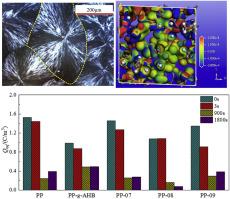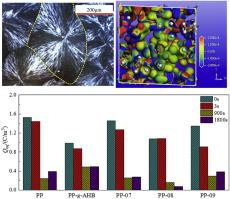氢键构建PP/ETFE共晶超分子机理及其空间电荷特性研究
IF 4.5
2区 化学
Q2 POLYMER SCIENCE
引用次数: 0
摘要
聚丙烯(PP)作为新一代电缆绝缘材料,取代交联聚乙烯(pe)而备受关注。但是,为了保证高压直流电缆的安全运行,高场强下的空间电荷积累还需要改进。在这里,PP与丙烯氧基-2-羟基二苯甲酮(AHB)化学接枝形成PP-g-AHB,乙烯四氟乙烯共聚物(ETFE)与甘油(GL)化学接枝得到ETFE-g-GL。然后通过熔融共混法制备了PP/ETFE共晶超分子。采用分子动力学模拟方法,结合微观结构表征,研究了氢键对PP/ETFE共晶超分子空间电荷抑制的影响。模拟和实验表明,PP-g- ahb和ETFE-g- gl由于氢键的存在,可以很好地形成PP/ETFE共晶超分子。当PP-g- ahb质量分数为80%时,PP/ETFE超分子共结晶尺寸达到390±10 μm。在直流源作用下,PP/ETFE共晶超分子的载流子迁移率低至7.94×10-13m2/(V。s),当平均电荷密度最小为0.08 C/m3时,空间电荷以异极性为主。目前,PP/ETFE共晶超分子的电荷输运特性以氢键为桥得到了显著改善。本研究为PP在高压直流电缆绝缘中的应用奠定了基础。本文章由计算机程序翻译,如有差异,请以英文原文为准。


Study on the mechanism of hydrogen bond to construct PP/ETFE Co-crystalline supramolecules and its space charge characteristics
As a new-generation cable insulation material, polypropylene (PP) has received much attention and replaced crosslinked polyethylene. However, the space charge accumulation under high fields still needs to be improved to ensure the safe operation of high-voltage direct current (HVDC) cables. Here, PP was chemically grafted with propenoxy-2-hydroxybenzophenone (AHB) to form PP-g-AHB, and ethylene tetrafluoroethylene copolymer (ETFE) was chemically grafted with glycerol (GL) to obtain ETFE-g-GL. Then PP/ETFE co-crystalline supramolecules were prepared via melt blending. The effect of hydrogen bonds on the space charge inhibition of PP/ETFE co-crystalline supramolecules was investigated using molecular dynamics simulation of differential charge density, energy band, and trap energy level combined with microstructure characterization. Simulations and experiments show that PP-g-AHB and ETFE-g-GL can form PP/ETFE co-crystalline supramolecules very well, owing to the existence of hydrogen bonds. When the mass fraction of PP-g-AHB is 80 %, the cocrystallization size of PP/ETFE supramolecules maximizes to 390 ± 10 μm. Under the action of direct current source, the carrier mobility of PP/ETFE co-crystalline supramolecules is as low as 7.94 × 10−13m2/(V.s), and the space charge is dominated by heteropolarity, when the average charge density minimizes to 0.08 C/m3. So far, the charge transport characteristics of PP/ETFE co-crystalline supramoleculars have been significantly improved using hydrogen bonds as a bridge. This study lays a foundation for the application of PP in HVDC cable insulation.
求助全文
通过发布文献求助,成功后即可免费获取论文全文。
去求助
来源期刊

Polymer
化学-高分子科学
CiteScore
7.90
自引率
8.70%
发文量
959
审稿时长
32 days
期刊介绍:
Polymer is an interdisciplinary journal dedicated to publishing innovative and significant advances in Polymer Physics, Chemistry and Technology. We welcome submissions on polymer hybrids, nanocomposites, characterisation and self-assembly. Polymer also publishes work on the technological application of polymers in energy and optoelectronics.
The main scope is covered but not limited to the following core areas:
Polymer Materials
Nanocomposites and hybrid nanomaterials
Polymer blends, films, fibres, networks and porous materials
Physical Characterization
Characterisation, modelling and simulation* of molecular and materials properties in bulk, solution, and thin films
Polymer Engineering
Advanced multiscale processing methods
Polymer Synthesis, Modification and Self-assembly
Including designer polymer architectures, mechanisms and kinetics, and supramolecular polymerization
Technological Applications
Polymers for energy generation and storage
Polymer membranes for separation technology
Polymers for opto- and microelectronics.
 求助内容:
求助内容: 应助结果提醒方式:
应助结果提醒方式:


